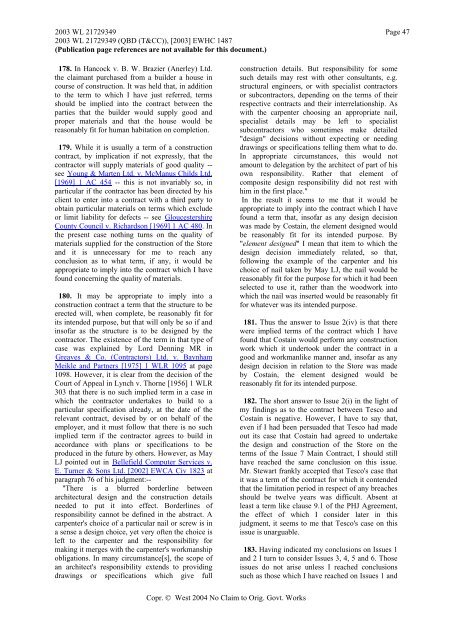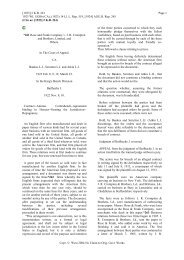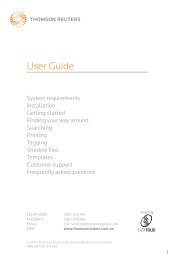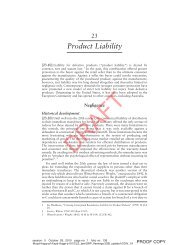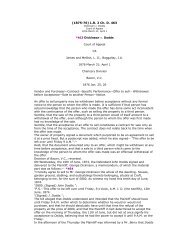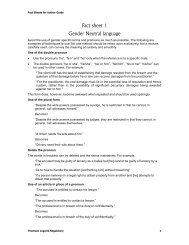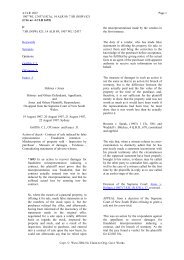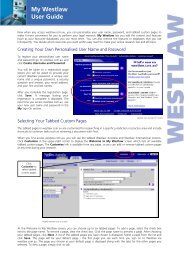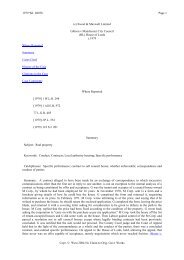Tesco v Constain - Thomson Reuters
Tesco v Constain - Thomson Reuters
Tesco v Constain - Thomson Reuters
Create successful ePaper yourself
Turn your PDF publications into a flip-book with our unique Google optimized e-Paper software.
2003 WL 21729349 Page 472003 WL 21729349 (QBD (T&CC)), [2003] EWHC 1487(Publication page references are not available for this document.)178. In Hancock v. B. W. Brazier (Anerley) Ltd.the claimant purchased from a builder a house incourse of construction. It was held that, in additionto the term to which I have just referred, termsshould be implied into the contract between theparties that the builder would supply good andproper materials and that the house would bereasonably fit for human habitation on completion.179. While it is usually a term of a constructioncontract, by implication if not expressly, that thecontractor will supply materials of good quality --see HYoung & Marten Ltd. v. McManus Childs Ltd.[1969] 1 AC 454 -- this is not invariably so, inparticular if the contractor has been directed by hisclient to enter into a contract with a third party toobtain particular materials on terms which excludeor limit liability for defects -- see HGloucestershireCounty Council v. Richardson [1969] 1 AC 480. Inthe present case nothing turns on the quality ofmaterials supplied for the construction of the Storeand it is unnecessary for me to reach anyconclusion as to what term, if any, it would beappropriate to imply into the contract which I havefound concerning the quality of materials.180. It may be appropriate to imply into aconstruction contract a term that the structure to beerected will, when complete, be reasonably fit forits intended purpose, but that will only be so if andinsofar as the structure is to be designed by thecontractor. The existence of the term in that type ofcase was explained by Lord Denning MR inHGreaves & Co. (Contractors) Ltd. v. BaynhamMeikle and Partners [1975] 1 WLR 1095 at page1098. However, it is clear from the decision of theCourt of Appeal in Lynch v. Thorne [1956] 1 WLR303 that there is no such implied term in a case inwhich the contractor undertakes to build to aparticular specification already, at the date of therelevant contract, devised by or on behalf of theemployer, and it must follow that there is no suchimplied term if the contractor agrees to build inaccordance with plans or specifications to beproduced in the future by others. However, as MayLJ pointed out in HBellefield Computer Services v.E. Turner & Sons Ltd. [2002] EWCA Civ 1823 atparagraph 76 of his judgment:--"There is a blurred borderline betweenarchitectural design and the construction detailsneeded to put it into effect. Borderlines ofresponsibility cannot be defined in the abstract. Acarpenter's choice of a particular nail or screw is ina sense a design choice, yet very often the choice isleft to the carpenter and the responsibility formaking it merges with the carpenter's workmanshipobligations. In many circumstance[s], the scope ofan architect's responsibility extends to providingdrawings or specifications which give fullconstruction details. But responsibility for somesuch details may rest with other consultants, e.g.structural engineers, or with specialist contractorsor subcontractors, depending on the terms of theirrespective contracts and their interrelationship. Aswith the carpenter choosing an appropriate nail,specialist details may be left to specialistsubcontractors who sometimes make detailed"design" decisions without expecting or needingdrawings or specifications telling them what to do.In appropriate circumstances, this would notamount to delegation by the architect of part of hisown responsibility. Rather that element ofcomposite design responsibility did not rest withhim in the first place."In the result it seems to me that it would beappropriate to imply into the contract which I havefound a term that, insofar as any design decisionwas made by Costain, the element designed wouldbe reasonably fit for its intended purpose. By"element designed" I mean that item to which thedesign decision immediately related, so that,following the example of the carpenter and hischoice of nail taken by May LJ, the nail would bereasonably fit for the purpose for which it had beenselected to use it, rather than the woodwork intowhich the nail was inserted would be reasonably fitfor whatever was its intended purpose.181. Thus the answer to Issue 2(iv) is that therewere implied terms of the contract which I havefound that Costain would perform any constructionwork which it undertook under the contract in agood and workmanlike manner and, insofar as anydesign decision in relation to the Store was madeby Costain, the element designed would bereasonably fit for its intended purpose.182. The short answer to Issue 2(i) in the light ofmy findings as to the contract between <strong>Tesco</strong> andCostain is negative. However, I have to say that,even if I had been persuaded that <strong>Tesco</strong> had madeout its case that Costain had agreed to undertakethe design and construction of the Store on theterms of the Issue 7 Main Contract, I should stillhave reached the same conclusion on this issue.Mr. Stewart frankly accepted that <strong>Tesco</strong>'s case thatit was a term of the contract for which it contendedthat the limitation period in respect of any breachesshould be twelve years was difficult. Absent atleast a term like clause 9.1 of the PHJ Agreement,the effect of which I consider later in thisjudgment, it seems to me that <strong>Tesco</strong>'s case on thisissue is unarguable.183. Having indicated my conclusions on Issues 1and 2 I turn to consider Issues 3, 4, 5 and 6. Thoseissues do not arise unless I reached conclusionssuch as those which I have reached on Issues 1 andCopr. © West 2004 No Claim to Orig. Govt. Works


